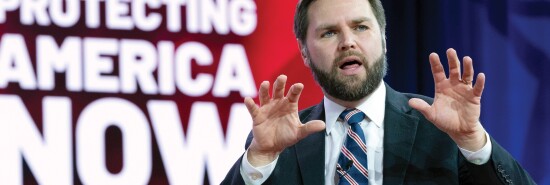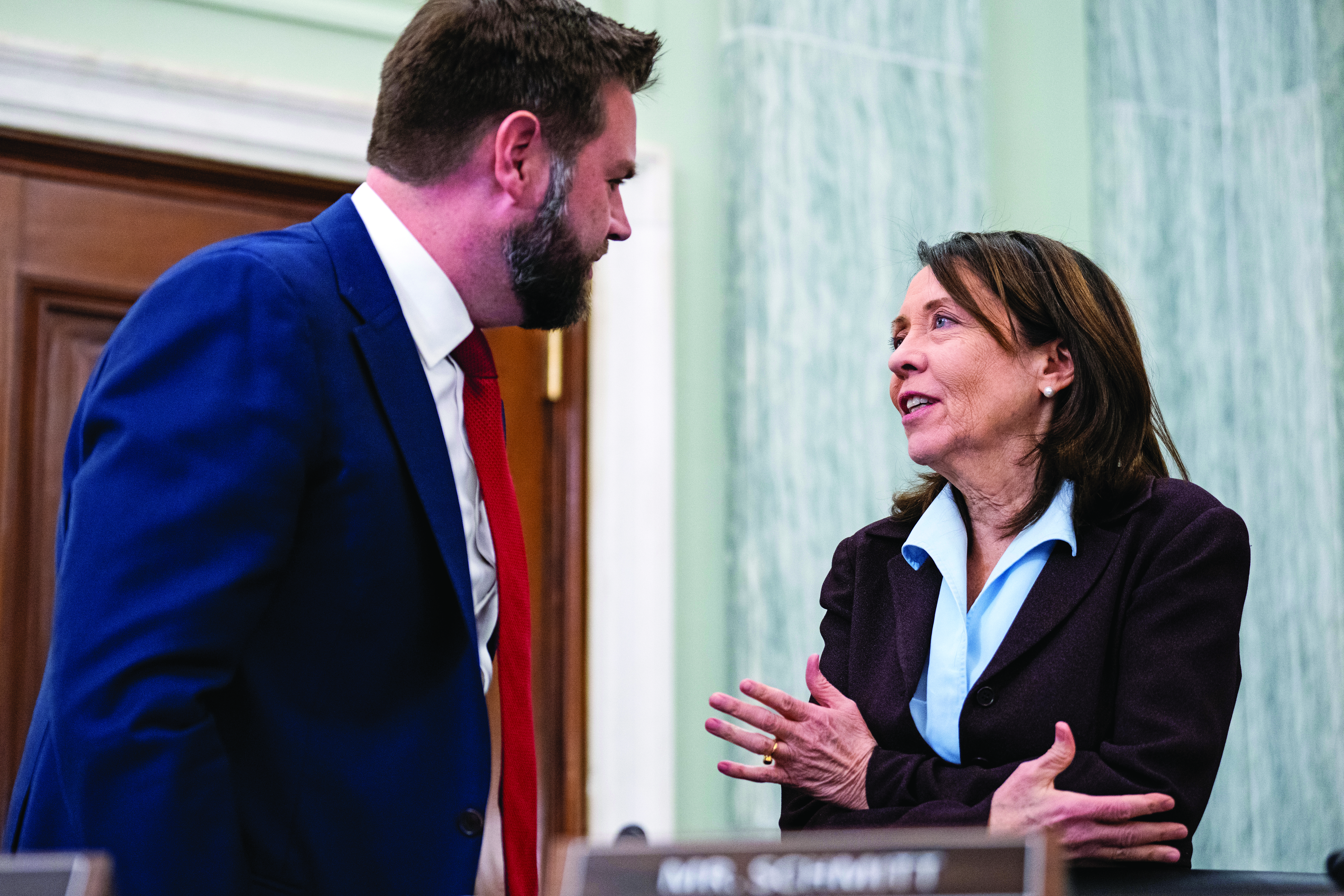
The riddle of JD Vance
Salena Zito
CINCINNATI — When J.D. Vance walked into the surgical technology class at Great Oaks Career Campuses, the vo-tech students were steeling themselves for final exams. Yet it turned out to be perfect timing. Vance was only planning to observe the class, but when he noticed that one of the students was anxious about having her blood drawn by her classmate, the Republican senator of Ohio casually removed his suit jacket and offered to take her place. When no objection from the teacher or students materialized, he sat down, rolled up his sleeves, and smiled.
To the clearly nervous student about to stick a needle in his arm, Vance said quietly, “Don’t be nervous. If you have to do it again, it’s fine with me. I am here for you until you get it right.”
The student got it done on the first jab.
The instructor looked at Vance with a broad smile. “Well, that wasn’t something I expected I’d see from you today.”
Confounding expectations is turning into something of a habit for Vance.
Eight months after winning Ohio’s U.S. Senate seat over Democrat Tim Ryan and a year after winning one of the wildest, smash-mouth primary races in the Buckeye State’s history, with both races having former President Donald Trump’s hands all over them, Vance is not the fire-breather the press predicted he would be. Neither, of course, is he his mild and wonkish predecessor, former Sen. Rob Portman.
Vance is just fine not fitting in any of those molds.

Sitting comfortably in a sunny high school conference room on the west side of Cincinnati, Vance has just finished spending most of a Friday morning touring the Diamond Oaks campus of the technical school. Throughout the two-hour visit, he walked into each classroom, watching the 11th and 12th graders show off their skills as he chatted with them about what they were going to do with the certificates they were earning in carpentry, graphic design, auto mechanics, coding, cosmetology, and welding after they graduated.
When Vance arrived earlier in the day and walked up to greet the principal, he got his own surprise.
“I went to shake his hand and I thought he looks familiar, and then I realized, oh my God, that’s Mr. Rush, my high school government teacher. And I gave him a big hug. And it was just fun to walk around with him and see him as the principal at this place,” he said.
The night before his visit here, he had been in Oxon Hill, Maryland, at the Heritage Foundation’s 50th Anniversary Leadership Summit, warning that the greatest threat facing America is a Chinese invasion of Taiwan while President Joe Biden is sending U.S. foreign aid to Ukraine.
Parma, Ohio, has one of the largest Ukrainian American populations in the state, but Vance said in a wide-ranging interview he has remained true to his convictions then and now about how he sees the U.S. involvement in Ukraine.
“What I’m trying to get people to understand is that our capacity to help people overseas is entirely dependent on our strength here at home,” Vance told the Washington Examiner.
“In particular, what I’ve been really startled by is if you look at the weapons systems we’ve been delivering to Ukraine and the weapons systems we have to deliver to Taiwan, there just aren’t enough to go around,” he warned.
“I think we should be more focused on China than we should be on Russia. But set aside whatever your foreign policy preferences are, the fundamental issue is that if we’re going to be the arsenal of democracy, we have to do the arsenal part,” he said of the American capacity to make the weapons needed to supply both countries with support. “We don’t make enough of it.”
A European Union memo dated March 13 estimated that Russia fires between 20,000 to 50,000 artillery rounds per day and Ukraine, 4,000 — a quarter of which come from the U.S. Under the most conservative estimates, “the Russians are able to do around 20 to one” compared to “the most powerful economy in the world,” which “suggests something’s really broken,” Vance said.
This concern is consistent both with Vance’s skepticism of U.S. intervention in Ukraine and a more immediate worry of his: America’s manufacturing base and its workforce.
“The single most important thing that we can do in foreign policy is prevent the Chinese from invading Taiwan — it would be economically devastating and would announce China as a true superpower in the world,” he said. America’s best chance to prevent that invasion is to provide Taiwan with the weaponry that would deter Beijing. “But if we can’t manufacture those weapons, they’re going to be in a rough spot, and so are we.”
The public may not quite be ready to choose between helping Ukraine and helping Taiwan, but if forced to prioritize, recent polling suggests a trend toward Vance’s position.
A Pew Research Center survey taken as the Biden administration was ramping up more military aid to Ukraine in January showed the share of voters who say the U.S. is providing too much support, 26%, has grown 6 percentage points since last September and 19 points since shortly after Russia launched its invasion of Ukraine in 2022.
In a Pew survey last month, 47% said tensions between mainland China and Taiwan are a very serious problem for the U.S., up 4 percentage points since October 2022 and 19 points since February 2021.
The Middletown-born author of the memoir Hillbilly Elegy had been treated as a translator for Rust Belt populists, but Vance’s Trumpist turn convinced many of his now-colleagues that he was simply part of the problem. (Vance has already backed Trump in the 2024 nomination contest.)
Perhaps that’s why in his first 200-plus days in the upper chamber, Vance has tried to find common ground. “I get along quite well with Chris Murphy. Smart guy, far to the left of me, but we have some areas of agreement and some things I think we’re going to be able to work on together,” he said of the Democratic junior senator from Connecticut, whose diplomatic nominee Stephanie Sullivan Vance blocked in July.
“Look, I mean, Chris Coons, I like Chris Coons. Chris Coons and I just had a debate about a Biden administration ambassador, and he got pretty pissed about it. But afterwards, we talked about it, and it’s fine. You disagree with each other, and you do what you have to do,” he said of Delaware’s junior senator, also a Democrat.
“On our side, I think the two guys who I just naturally get along with the best are Josh Hawley and Tom Cotton,” he said of the Missouri and Arkansas senators.
“They are younger. They both got young kids. They both know what it’s like when crazy people harass your family. And so I think there’s just a natural friendship and bond that’s formed between me and the two of them. But Marco Rubio and I get along great. John Barrasso, love John Barrasso. John Cornyn and I get along. Just by and large, we actually like each other, even [amid] the really strong political disagreements,” he explained.
Sometimes events force the kind of cooperation that might not have come naturally. Vance’s first month in office was a baptism by fire of sorts in having to respond to the catastrophic Norfolk Southern train derailment in East Palestine and subsequent toxic control burn. Within days, both he and his fellow Ohio senator, Democrat Sherrod Brown, found themselves an unlikely duo both in Columbiana County and in Congress trying to get to the bottom of what happened.
“In that case, I think working on railway safety in a way where we could get both the railroads open to it and get both Democrats and Republicans to actually move this thing” enabled everyone involved to put aside their egos, Vance suggested. “It’s pure practicality. You have to do something. How do you get something done? You’ve got to work with somebody. Well, I guess I’m going to go work with that person.”
The resulting railroad legislation, the Rail Safety Act of 2023, of which Vance was an original co-sponsor, passed through the Senate’s Commerce, Science, and Transportation Committee in May. It was so bipartisan that both Trump and Biden gave it their full-throated support.
For Vance, it felt personal. “What happened in East Palestine was something that affected people that I care about. And you had just had to get it done,” he said.
A year ago, when Vance won the Republican primary, the narrative was that he was riding the wave of resentment politics. But the reason he remains something of a puzzle to the press and his colleagues is that he isn’t driven by any one thing. There is no doubt he is a leading player in the conservative populist rebellion against “the establishment.” It’s also clear his Appalachian roots, military service in the Marines, education at Yale, and early career in Silicon Valley play important, and sometimes contradictory, roles in his worldview. When talking about Ukraine, for example, he grows frustrated with the difficulty many policymakers have in visualizing what life in uniform is like.
“I thought, [No. 1], that a lot of people in Washington don’t know the guys who are actually fighting the battles,” he said. “And No. 2, a lot of them think of war in philosophical terms. And in reality, it’s about good men and women, it’s about their training, it’s about how cohesive they are, and it’s about whether they have enough bullets in their guns.”
Vance says some call him a realist, but “I don’t really know what that is. I didn’t study foreign policy when I was in school, so I don’t know exactly where to place myself. But I think that the thing that really matters in the world is not how tough you think you are. It’s not what you say. It’s not what you believe. It’s what you do and how strong you are.”
CLICK HERE TO READ MORE FROM THE WASHINGTON EXAMINER
Vance is still a conservative populist, still a hardcore Trump supporter. But he has also introduced legislation with Sens. Elizabeth Warren (D-MA), Tammy Baldwin (D-WI), and Mark Kelly (D-AZ).
Vance smiles at the notion of not fitting into someone else’s caricature of him, then heads off to catch up with his old high school government teacher.
Salena Zito is a national political reporter for the Washington Examiner.
